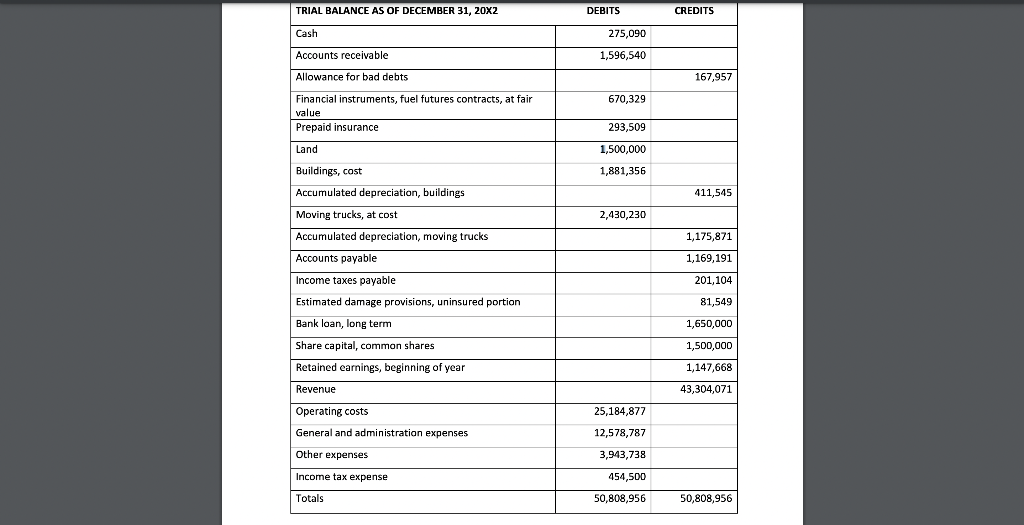Question
You have been assigned to the audit of the financial statements of Office Moving and Storage Limited (OMS) for its year ending December 31, 20X2.
You have been assigned to the audit of the financial statements of Office Moving and Storage Limited (OMS) for its year ending December 31, 20X2. The company started 10 years ago and is in the business of moving furniture and equipment for company offices across Canada, and also providing storage for companies requiring that service. While the company has been operating for many years, this is the first year that they require an audit due to new debt acquired. The company is owned by three shareholders, who are all involved in operating the company. OMS owns four properties outside of major urban centres; this is where it has warehouse buildings for storing customers furniture and garages for parking its own moving trucks. OMS has a force of salespeople who follow commercial real estate construction and leasing reports to identify sales prospects: large and medium-size companies that are planning to move offices. The prospects are assigned to salespeople who then follow up and try to sell a moving and storage contract to the company, along with other services to facilitate the office move. The salespeople prepare a cost quote for doing the move, which must be approved by the regional sales manager before giving it to the prospect company. The regional sales managers have the authority to lower the quoted price if a competing moving company undercuts OMSs. Once a move has been started, in many cases the customer requires extra services beyond those contracted for (such as extra boxes, packing, disassembling furniture, or removal of garbage), and these are billed as extra charges. The moving employees on the job record the types of extra services provided in a Customer Moving Job Report. These extras are then priced by the assistant sales managers and added to the amount billed to the customer. Customers with approved credit ratings are required to pay 25% of the contracted price as a deposit and are billed for the remaining contract cost and any extras after the move is completed. They have 10 days to pay in full. Customers without approved credit ratings are required to pay the full contract price in advance, and if any extra service charges arise during the move, they must pay the moving employees for these in cash at the time of the move. In the preliminary audit planning done to date, your audit manager has determined that revenues are the class of transactions with the highest risk of material misstatement. You have been assigned to continue the OMS audit planning work by finalizing and documenting various risk assessment and planning decisions so the audit team can move on to developing the detailed audit plans. It is now January 20X3, and you are at the OMS offices to begin your audit work. In discussion with the companys management, you have learned that OMS typically does about 3040 moves per month, with 40 being about the maximum number it can handle with its current employees and trucks. About 80% of its sales are on account to customers with good credit ratings; the balance of its sales are paid in advance. Starting in the current year, the company has purchased future contracts to lock in fuel prices, since fuel is a major operating expense. The companys policy is to value these future contracts at fair value in its year-end bala
sheet, with unrealized gains included in Revenues, and unrealized losses included in Operating Costs. The company is planning to expand its operations in the next two years by acquiring another established moving company that specializes in smaller company moves. The acquisition and expansion will be financed by issuing shares to other investors who will not be actively involved in the business. Exhibit I includes the December 31, 20X2 adjusted trial balance listing that you have obtained from OMSs management. Required Continue audit planning for OMS based on answering the following questions:
1. Identify three factors your audit firm would have had to consider in order to decide to accept the OMS audit engagement for the current year, and explain how each factor affects this acceptance decision.
2. Using the trial balance data above, analyze OMSs financial statements by calculating its current ratio and accounts receivable turnover ratio. (Note: Current ratio = Current assets/Current liabilities, and Accounts receivable turnover = Credit sales revenue for the year/Net accounts receivable at year-end.) Explain what this analysis can tell you about the risks in OMSs financial statements, and what further investigation the analytical results may suggest.
3.What materiality levels would you use to plan this audit? Show your calculations and justify your decision. You can assume your audit firm has the following policy: Performance materiality should be 70% of the overall materiality level for financial statements as a whole, unless specific information indicates a different value should be used.
4. What audit risk level would you be willing to accept for this engagement? Describe your choice in terms of one of these levels: high, medium, or low. Explain the factors that support your decision.
5. Based on the business risk analysis for OMS, your audit manager believes the OMS revenue class of transactions has the highest risk of material misstatement. Identify and explain three business risk factors in OMS that would support your managers assessment.
6. Your manager has asked you to assess the inherent risk of misstatement at the assertion level for the revenues. Use the level high or not high to describe your assessments, and explain the factors that support your assessments.
7. The manager of OMS has asked that you to draft a memo to explain how they can set the tone for a better control environment as they continue to expand as a business. Your memo should outline relevant principles and why they are important to apply to OMS.

urgent "but dont want copy and paste"
TRIAL BALANCE AS OF DECEMBER 31, 20X2 DEBITS CREDITS Cash 275,090 Accounts receivable 1,596,540 167,957 Allowance for bad debts Financial instruments, fuel futures contracts, at fair value Prepaid insurance 670,329 293,509 Land 1,500,000 1,881,356 Buildings, cost Accumulated depreciation, buildings 411,545 Moving trucks, at cost 2,430,230 1,175,871 1,169,191 Accumulated depreciation, moving trucks Accounts payable Income taxes payable Estimated damage provisions, uninsured portion 201,104 81,549 Bank loan, long term 1,650,000 1,500,000 1,147,668 Share capital, common shares , Retained earnings, beginning of year Revenue Operating costs General and administration expenses 43,304,071 25,184,877 12,578,787 Other expenses 3,943,738 Income tax expense 454,500 Totals 50,808,956 50,808,956Step by Step Solution
There are 3 Steps involved in it
Step: 1

Get Instant Access to Expert-Tailored Solutions
See step-by-step solutions with expert insights and AI powered tools for academic success
Step: 2

Step: 3

Ace Your Homework with AI
Get the answers you need in no time with our AI-driven, step-by-step assistance
Get Started


